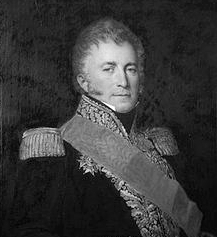General Bertrand-Pierre Castex

Born: June 29, 1771
Place of Birth: Pavie, Gers, France
Died: April 19, 1842
Place of Death: Strasbourg, France
Arc de Triomphe: CASTEX on the west pillar
Pronunciation:
Like many soldiers during the Revolution, Bertrand-Pierre Castex volunteered to join the army, joining the Chasseurs à Cheval of Gers in July of 1792. The next year he was sent to the Army of the Western Pyrenees where he received a promotion to sous-lieutenant. In July of 1795 Castex was promoted to lieutenant and then with the dissolution of the Army of the Western Pyrenees later that year he was sent to the Army of Italy. Castex served with the Army of Italy for the next few years, in the meantime in 1796 he was named an aide-de-camp of General Kilmaine during the Siege of Mantua. In January of 1797 he received a promotion to capitaine, and then in December of 1800 he was promoted to chef d'escadron.
During the peaceful years that followed, Castex was appointed a major of the 20th Chasseurs à Cheval in 1803. He served in Holland over the following years and then in March of 1806 his colonel was accused by many officers of embezzlement. Therefore, Castex was ordered to take command of the regiment and he led them to join the Grande Armée for the campaign against Prussia of 1806. That October he led his men into action at the Battle of Jena and a week later he was promoted to colonel of the 20th Chasseurs à Cheval. In December of 1806 Castex's unit was placed as part of Lasalle's division and then in February of 1807 they served at the Battle of Eylau. After the campaign resumed later that year, he and his men served at the Battle of Friedland.
Colonel Castex remained in charge of his chasseurs à cheval and their next action came in 1809 when Austria declared war on France and her allies. Castex and his men were attached to General Oudinot's command and they served at Amstetten in May. That June they joined Colbert's brigade and then in July they charged at the Battle of Wagram . Two weeks later Castex was promoted to général de brigade of the 3rd Brigade of Light Cavalry. At the end of October he was sent as inspector of cavalry to the 5th military division.
In 1810 Castex was sent to the Army of Brabant and then the camp of Boulogne. In 1811 he took command of a brigade of cavalry at Munster and then served under Marshal Davout. As the Grande Armée prepared for war against Russia in 1812, Castex took command of the light cavalry of Marshal Oudinot's II Corps. Serving under Oudinot, he fought at Ostrowno in July and then Polotsk in August. During the retreat that followed, Castex fought at the Battle of the Berezina where he was wounded by a bayonet blow to the thigh. Nevertheless he continued to serve during the retreat until the army reached Wilna.
In February of 1813 Castex was appointed a major of the Grenadiers à Cheval of the Imperial Guard. For the campaigns in Germany that followed, he served in Doumerc's division and he fought and was wounded at the Battle of Dresden in August. Castex went on to serve at Altenburg in September where he was again wounded, this time time by a saber blow to the right knee. In October he served at the Battle of Leipzig and the Battle of Hanau and then in November he was promoted to général de division.
For the defense of France of 1814, Castex was placed under General Maison's overall command. He fought at Saint-Trond in January where he was beaten and also wounded by a shot to the chest. That March he served at Courtrai and then after Napoleon's abdication in April Castex was put on non-activity by the restored Bourbons. When Napoleon returned from exile and resumed power in 1815 for the Hundred Days, Castex supported Napoleon and was placed in charge of the 9th Cavalry Division of Lecourbe's corps. After Napoleon's second abdication and the Second Restoration of the Bourbons, Castex was put on non-activity.
Bibliography
Updated March 2025
© Nathan D. Jensen